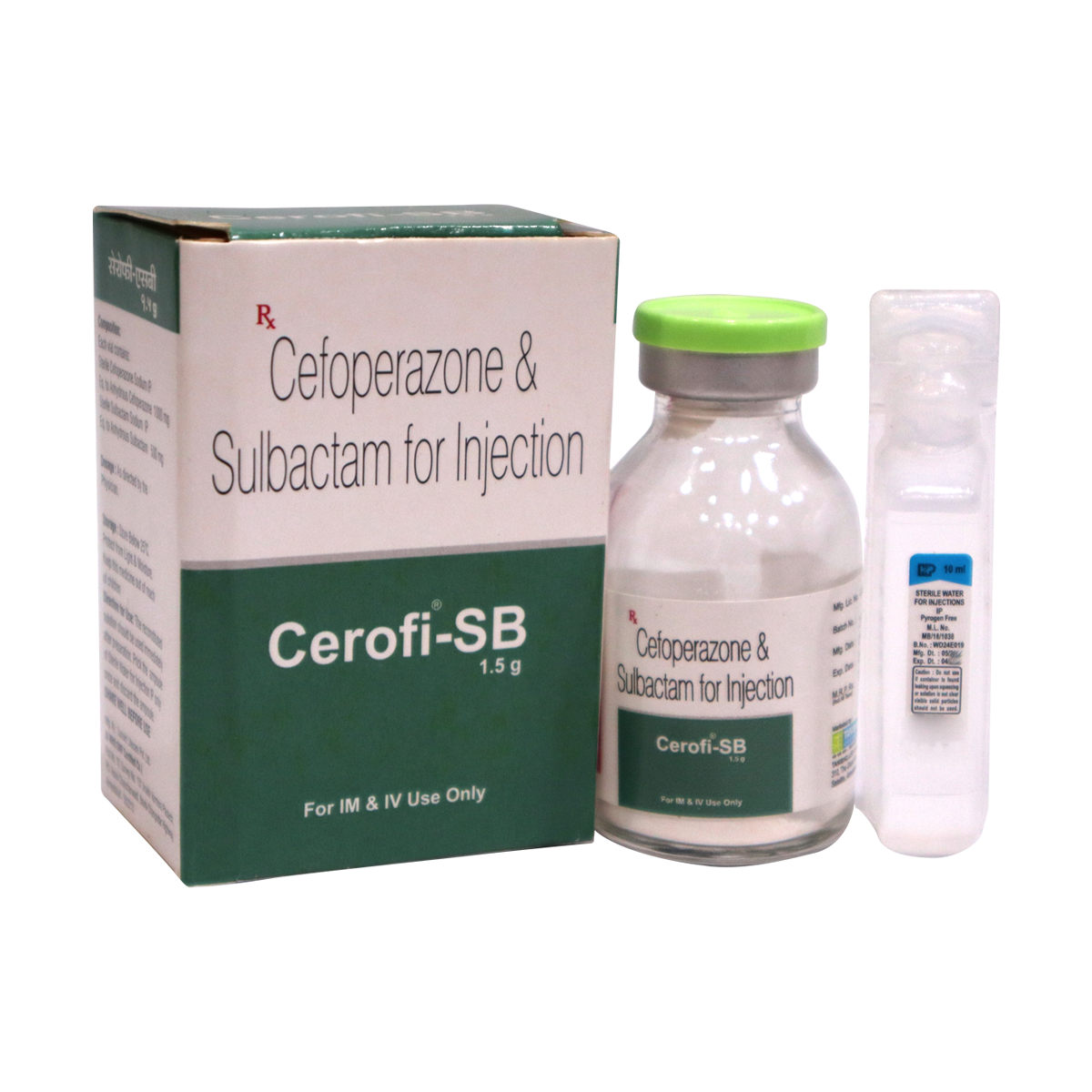
Cerofi-SB inj.
CEROFI-SB is a combination injection containing Cefoperazone (a broad-spectrum cephalosporin antibiotic) and Sulbactam (a beta-lactamase inhibitor). This combination enhances the antibacterial activity of Cefoperazone by inhibiting beta-lactamases, enzymes produced by certain bacteria to resist the effects of antibiotics.
- Recommended Usage
Indications
- Bacterial Infections: Treats a wide range of serious bacterial infections, including:
- Respiratory Tract Infections (e.g., pneumonia, bronchitis)
- Urinary Tract Infections (e.g., cystitis, pyelonephritis)
- Intra-abdominal Infections (e.g., peritonitis, abscesses)
- Skin and Soft Tissue Infections
- Bone and Joint Infections
- Septicemia (bacterial bloodstream infections)
- Meningitis
- Gynaecological Infections (e.g., pelvic inflammatory disease)
- Post-surgical Infections (for prophylaxis and treatment)
Sulbactam in this combination enhances the efficacy of Cefoperazone against beta-lactamase-producing organisms, making it particularly effective against resistant strains.
Dosage and Administration
• Route of Administration: Intravenous (IV) or Intramuscular (IM) injection.
Typical Dose for Adults:
- General Infections: 1-2 grams of Cefoperazone (corresponding to 500mg-1g of Sulbactam) every 12 hours, depending on the severity of the infection.
- Severe Infections: The dosage may be increased up to 4 grams of Cefoperazone daily (with appropriate Sulbactam dosage).
Dosage Adjustments: For patients with renal or hepatic impairment, dose adjustments may be necessary.
Administration: For IV administration, reconstitute with an appropriate diluent such as sterile water or saline. IM administration should use a suitable diluent to minimize pain at the injection site.
Precautions
Hypersensitivity: Avoid in patients with a known hypersensitivity to Cefoperazone, Sulbactam, or other beta-lactam antibiotics.
Allergic Reactions: Discontinue the drug if allergic reactions such as rash, anaphylaxis, or eosinophilia occur.
Renal and Hepatic Impairment: Use with caution in patients with impaired kidney or liver function, as these conditions may affect drug metabolism and excretion.
Neonates: Cefoperazone should not be used in neonates who require calcium-containing solutions due to the risk of precipitation.
Pregnancy and Breastfeeding: Use during pregnancy only if absolutely necessary. It is excreted in breast milk and should be used cautiously while breastfeeding.
Superinfection: Prolonged use may lead to the development of resistant organisms or superinfections.
Gastrointestinal Issues: May cause diarrhea, including Clostridium difficile-associated diarrhea.
Benefits
Broad-Spectrum Activity: Effective against a wide range of Gram-positive and Gram-negative bacteria, including resistant strains, due to the inclusion of Sulbactam.
Enhanced Efficacy: Sulbactam inhibits beta-lactamase enzymes, enhancing the activity of Cefoperazone against resistant organisms.
Treatment of Serious Infections: Suitable for treating severe infections like septicemia, pneumonia, meningitis, and post-surgical infections.
Convenient Dosing: Dosing typically every 12 hours for many infections, allowing ease of administration in hospital settings.
Prophylaxis and Therapeutic Use: Can be used for both prophylactic purposes before surgery and to treat established infections.
Product Category
- Anti Infective
- Injectables
- Pre Filled Syringe
- Immunosuppressants
- Anti Ulcerant/ppis
- Joint Care
- Enzymes
- Heamatinic Agents
- Antioxidant Multivitamins
- Laxatives
- Anti Alergic
- Corticosteroids & Combinations
- Anti Fungal
- Medicated Soaps
- Emollients and Moisturisers
- Face Care
- Puva & Sun Protectors
- Hair Care
- Anti Acne Preparation
- Analgesics Antipyretics & Anti Inflammatory
- Anti Spasmodic & Anti Emetic
- Expectorants Antitussives & Mucolytics
- Antidiarrheals
- Cardiac Drugs
- Antipsychotics
- Anti Epileptics
- Migraine
- Anti Dyspetic
